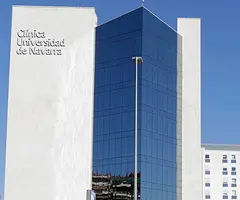Spinal Tumors
"Surgery for vertebral tumors is usually very aggressive and complicated. If the resection is performed completely and en bloc, the success rates increase significantly."
DR. VÍCTOR RODRIGO
DIRECTOR. NEUROSURGERY DEPARTMENT

What is a spinal tumour?
Spinal tumours are classified according to their location:
- Intramedullary tumours: these are clusters of cells that originate from nerve tissue, such as ependymomas or astrocytomas. They usually grow in such a way that they deform the spinal cord causing neurological damage such as motor and/or sensory deficits. Sometimes they form internal cysts.
- Extramedullary tumours: these are the result of a proliferation of the cells that support and maintain the nerve cells of the spinal cord. Their growth is external to the medulla, but they cause neuronal damage by compression. They include schwannomas (neurinomas, from the nerve sheath) and meningiomas (from the covering of the central nervous system or meninges).
A large number of tumours that arise within the canal may also arise from tumours located elsewhere in the body that release cancer cells that deposit in the spinal canal (metastasis). They can affect the medulla itself or also extramedullary.

A PERSONALIZED MEDICINE
Second Opinion,
peace of mind
Request a second opinion from our professionals with great experience in the diagnosis and treatment of oncological diseases
In 3 days, without leaving home.
Symptoms of spinal tumours
Any growth of a mass within the canal can damage the nervous system, since it is a very small space and not prepared to expand, so any type of tumour, malignant or benign, can cause neurological damage and put the patient's life at risk.
Depending on the location of the lesion, the upper limbs (cervical) or legs (dorsal and lumbar) will be more affected. The cervical location may also affect both. Other symptoms may include weakness, urinary or faecal incontinence, changes in sensation, incoordination and gait instability.
Pain can be a symptom caused by a spinal tumour, either local or radiating. It usually manifests itself as discomfort that typically worsens at night, in a progressive and persistent manner.
The most common symptoms are:
- Upper or lower limb involvement (depending on the location of the tumour).
- Weakness
- Urinary or faecal incontinence
- Sensory disturbances
- Incoordination or unsteadiness in walking
Do you have any of these symptoms?
If you suspect that you have any of the above symptoms,
you should consult a medical specialist for a diagnosis.
How are spinal tumours diagnosed?
Spinal tumours are neoplasms that affect the spinal column, they can affect the bone and its appendages (vertebral tumour), or they can be found in the vertebral canal and damage nerve structures (myelo-radicular tumour).
They are generally diagnosed by magnetic resonance imaging (MRI), although tomography or scanning (CT), PET, etc. are also very useful.
How are spinal tumours treated?
The main treatment for most spinal tumours is their removal, especially when they are benign. If the diagnosis indicates malignancy, the patient may also benefit from other adjuvant cancer therapies, such as chemotherapy or radiotherapy.
The prognosis of the lesion will depend on the degree of malignancy and the patient's stage.
If too much time elapses before diagnosis and/or treatment, symptomatology (such as paralysis of a limb or altered sensation) may become irreversible.
However, early diagnosis significantly increases the likelihood of successful treatment and recovery from symptoms.
Proton therapy for cancer
Proton therapy is the most precise external radiotherapy modality, providing better distribution of radiation dose and therefore less irradiation of healthy tissues.
The Proton Therapy Unit of the Cancer Center Clínica Universidad de Navarra in its Madrid headquarters is the most advanced in Europe and the first in a Cancer Center, with all its healthcare, academic and research support.
Where do we treat it?
IN NAVARRA
Central Nervous System Tumors Area
of the Cancer Center Clínica Universidad de Navarra
In the Central Nervous System Tumors Area we offer maximum safety and efficiency in brain tumor surgery, being the first hospital with a high field magnetic resonance within the operating room.
We have a highly specialized team in the surgery of brain tumors, with more than 15 years of experience.
The individualized treatment of each case by an interdisciplinary team allows us to offer the best alternative to each patient.

Why at the Clinica?
- Integral evaluation of the patient.
- Cutting edge technology.
- Expert professionals who are a national reference.



























